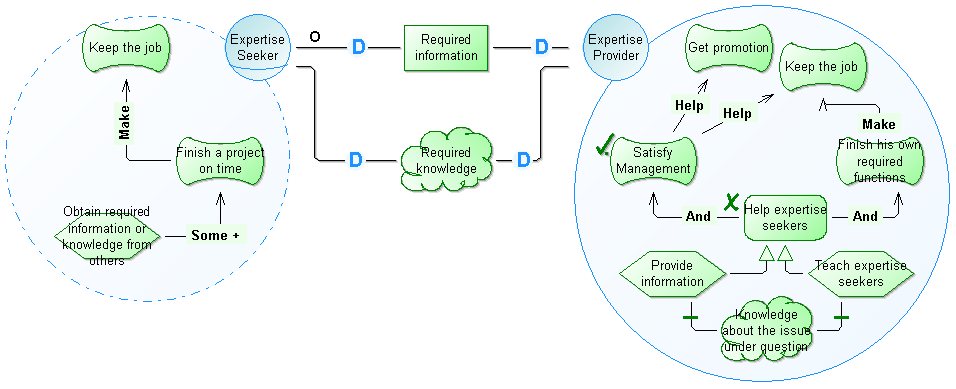Details
The i* Method has been developed at the University of Toronto and facilitates to show social relationships and their analysis. The name i* stands for distributed intentionality (Yu1995), referring to the premise that actors are intentional and that they do not necessarily share common goals (Samavi 2008). The i* Method offers two main conceptual parts. The first is the elaboration of a Strategic Dependency Model and the second the refinement to a Strategic Rational Model. These two parts are also a natural approach how to map existing information and further detail the different relationships. One could also say it is a "top down approach" according to the procedure setting-up the models.
The i* Method knows intentional actors, though the main element "actor" may adopt a "role", a "position" or represent an "agent". Intentional actors may pursue "goals", "softgoals", execute "tasks", use "resources" or have a certain valuation on the situation, strategic assumptions, which is shown in form of "beliefs". The elements are connected with different types of "links". Depending on the link type the relationship has a different meaning. Properties of the links further specify the social relationship within the scenario.
The planned project is initiated to elaborate an implementation concept for the i* Method on the Open Models Platform according to the definition of the method. The concept should show how the selected method can be implemented on such a platform, what are the requirements, preconditions, pitfalls, which extensions on the method are conceivable etc. As an extension a "stepper" through the different analysis stages of the models should be realized. This would help the "end-user" or reader of the model to easier follow the progress of the analysis results and therefore the refinement of the model over time as complexity is reduced. With such scalability considerations the usability and acceptance of the models should be increased. Furthermore predetermined reporting functionality for certain queries is also planned as reports seem to be useful during the analysis phase and scenario discussions.

Example: Simplified model of intentional relationships between expertise seeker and provider (Fazel-Zarandi, 2008)


